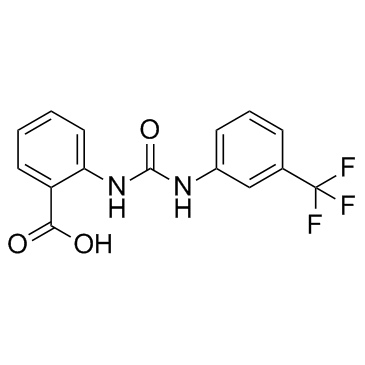| Description |
NS1652 is a reversible anion conductance inhibitor, blocks chloride channel, with an IC50 of 1.6 μM in human and mouse red blood cells.
|
| Related Catalog |
|
| Target |
IC50: 1.6 μM (chloride channel, human and mouse red blood cell)[1]
|
| In Vitro |
NS1652 potently inhibits the chloride conductance (IC50, 1.6 μM) in human and mouse red blood cells, but only weakly inhibits VRAC (IC50, 125 μM) in HEK293 cells. NS1652 markedly blocks the NO production with an IC50 of 3.1 μM in BV2 cells. NS1652 also down-regulates iNOS expression at 3 μM, and completely abolishes at 10 μM in BV2 cells[1]. NS1652 (0, 1.0, 3.3, 10, and 20 μM) causes increasing hyperpolarization due to inhibition of the chloride conductance in normal erythrocytes. NS1652 lowers the net KCl loss from deoxygenated sickle cells from about 12 mM cells/h to about 4 mM cells/h. NS1652 (20 μM) completely and reversiblely inhibits the red cell Cl-conductance[2].
|
| In Vivo |
NS1652 (50 mg/kg, i.v.) blocks murine erythrocyte Cl- conductance by >90% in mice[2].
|
| Animal Admin |
NS1652 is suspended in a carrying vehicle, cremophore (pig-40 hydrogenated castor oil), at a concentration of 5 mg/mL. At time zero, an amount corresponding to 1% of animal weight (about 250 μL of suspension) is injected into mice though the tail veins (NMRI strain, 5-6 weeks). At several time intervals after the injection, the mice are decapitated and the blood collected is collected and centrifuged for 60 seconds. The plasma is removed by aspiration and the packed cells are stored on ice until use. Immediately before measurement, the packed cells are resuspended in 1 volume of ice-cold experimental medium and centrifuged for 30 seconds. A total of 100 μL of packed cells are then immediately transferred to 3 mL medium, and CCCP and valinomycin added. The blood samples are analyzed in random order with respect to the time of decapitation[2].
|
| References |
[1]. Kjaer K, et al. Chloride channel blockers inhibit iNOS expression and NO production in IFNgamma-stimulated microglial BV2 cells. Brain Res. 2009 Jul 24;1281:15-24. [2]. Bennekou P, et al. Volume control in sickle cells is facilitated by the novel anion conductance inhibitor NS1652. Blood. 2000 Mar 1;95(5):1842-8.
|
